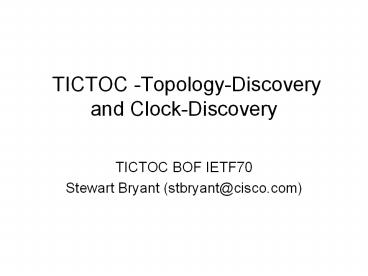TICTOC -Topology-Discovery and Clock-Discovery - PowerPoint PPT Presentation
Title:
TICTOC -Topology-Discovery and Clock-Discovery
Description:
... Discovery and Clock-Discovery. TICTOC BOF IETF70. Stewart Bryant (stbryant_at_cisco.com) Agenda. What problems do these discovery mechanisms ... Clock Discovery ... – PowerPoint PPT presentation
Number of Views:25
Avg rating:3.0/5.0
Title: TICTOC -Topology-Discovery and Clock-Discovery
1
TICTOC -Topology-Discovery and Clock-Discovery
- TICTOC BOF IETF70
- Stewart Bryant (stbryant_at_cisco.com)
2
Agenda
- What problems do these discovery mechanisms
solve? - Why should they be specified in the IETF?
3
Time Transfer in a Packet Network
- To acquire time a client (slave) needs to receive
time-stamped packets from a time server, AND it
needs to know how old the packet is when it
arrives. - All systems assume that the path is symmetric,
and therefore age is half the round trip time. - Link delay is often (but not always) constant,
but switch/router delay is load dependent. - There are three approaches to switch/router
delay - Find the lucky packets that experienced minimum
delay. - Boundary Clocks. Each switch/router becomes a
client to its parent router closer to the time
server and time server its child routers. - Transparent Clocks. Measure the queuing time at
each switch/router and either - Correct the timestamp in packet or
- Report the delay to the client.
4
Network Topology
- Network topology is usually formed dynamically
- It is usually the set of paths with the lowest
routing metric. - The best metric path is usually chosen for
highest bandwidth, but policy may be a factor. - The best data path may not be the best path for
time and frequency transfer.
5
Lucky Packet Path
Master
- Best data path from master to slave is M-A-B-C-S
- At each router there is a probability that the
timing pkt will be queued - O(phops) - Best time path may be M-D-S
- Best timing path may not be available through the
existing IGP - Best data path may not be reciprocal.
1
2
1
1
3
1
Slave
6
Boundary Clock Path
Master
- Optimum data path is M-A-B-C-S
- Data path A to D is via B and C, but B does not
support boundary clock - IEEE1588 uses link local addressing/forwarding,
application layer hellos, and application layer
routing. - Is this the best approach in the IETF
environment?
1
10
1
1
2
3
1
Slave
Note that the cascading of the clock servos
causes degradation of time quality. The extent is
implementation dependent. This was why IEEE1588
introduced transparent clocks.
7
Transparent Clock Mechanisms
One Step Transparent Clock
T
T
T
?t0
?t0 ?t1
?t0 ?t1 ?t2
T T ?t0 ?t1 ?t2
Two Step Transparent Clock
8
Transparent Clock Path
Master
- Optimum data path is M-A-B-C-S
- Data path A to D is via B and C, but B does not
support transparent clock - Sync packet is an ordinary packet, and so cannot
be forced using application layer routing.
1
10
1
1
2
3
1
Slave
9
Diverse Path
Master
- If the path to the master is lost the slave needs
to go into holdover. - Precision of clock and duration of holdover have
a direct effect on the cost of the slave. - Delivering clock over diverse paths can lead to a
reduction in slave cost. - Diverse path can also be used to good effect in
lucky packet clock algorithms, because the
probability of delay is statistically reduced.
1
3
1
1
3
1
Slave
10
Topology - conclusion
- The quality of time transfer is improved if the
network topology is optimized for the
application. - The optimum time transfer topology may not be
congruent with the optimum data topology. - Topology is controlled by routing, thus routing
support is needed to optimize time transfer. - The IETF is the design authority for routing
protocols. - Therefore to design the highest quality time
transfer protocol for IP networks the IETF has to
engage with the problem. - The proposal is NOT for TICTOC to design a new
routing protocol. - The proposal is for TICTOC to produce a time
distribution architecture, to identify the time
support routing requirements, and then to work
with the existing routing groups to define the
required protocol extensions.
11
Clock Discovery
- As time usage becomes more ubiquitous more nodes
need to be accurately synchronized to high
quality network clock. - Clock needs to be of adequate quality, have the
resources available to support the client and be
accessible via a time suitable network path. - When the clock fails the slave needs to find a
new clock - Initially clock-slave pairing will be statically
configured. - As the number of slaves increases and the demands
on time quality/availability increase static
configuration does not scale.
12
Network Environment
- Service Provider and enterprise network
environments are different - Routing protocols are different (e.g. BGP in SP
networks, but less likely in Enterprise networks) - SP networks have sophisticated provisioning
systems
13
Clock Discovery Protocol
- Given the symbiosis between routing and clock
distribution a clock discovery protocol based on
routing seems likely. - Extension of an IGP seems most likely to be
applicable to SP and Enterprise environments - BGP is the traditional method used for
discovery in SP networks.
14
Clock Discovery - Conclusion
- It is likely that as high quality time
distribution becomes an important element of the
network infrastructure a discovery mechanism will
be needed. - Given that a slave needs both a suitable clock
and a suitable path, there is some symbiosis with
routing. - This is an area that can only be effectively
addressed in the IETF.
15
Questions?































